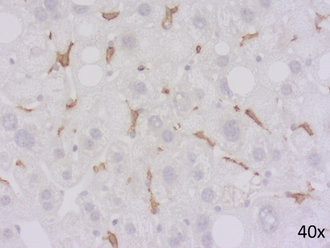
| Cat. No. HS-397 004 |
100 µl antiserum, lyophilized. For reconstitution add 100 µl H2O, then aliquot and store at -20°C until use. Antibodies should be stored at +4°C when still lyophilized. Do not freeze! |
| Applications | |
| Immunogen | Synthetic peptide corresponding to AA 28 to 42 from mouse F4/80 (UniProt Id: Q61549) |
| Reactivity |
Reacts with: mouse (Q61549). Other species not tested yet. |
| Data sheet | hs-397_004.pdf |

F4/80 positive cells in FFPE mouse liver section